#mica raku
Text


GRANDMA'S POT Angie Yazzie, hand coiled, raku fire Taos Pueblo mica clay, 19" x 19", $5,000
0 notes
Photo
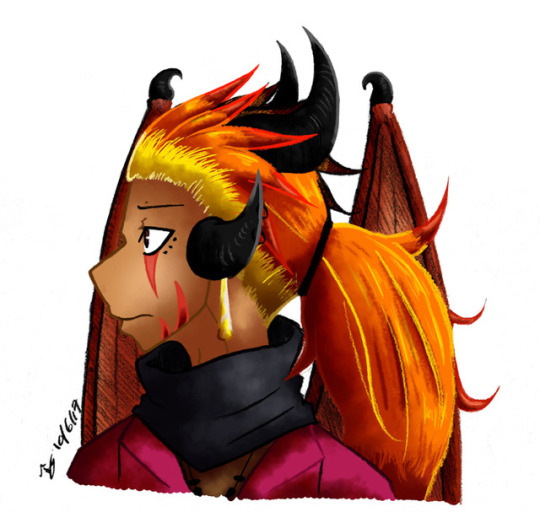



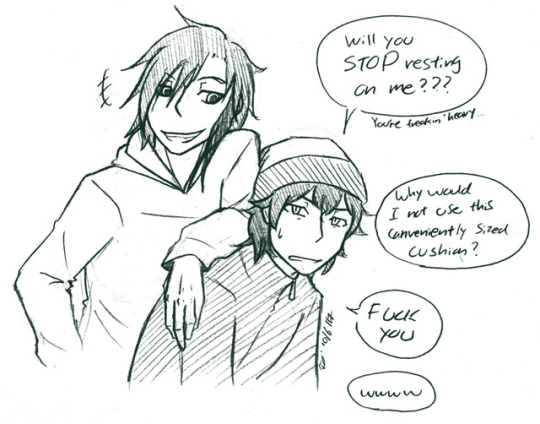

Sorry, not P5-related. They’re all my ocs.
I basically doodled to “collect some samples” to try different coloring and eeehhhh. I’m not really skilled with coloring so it’s expected that they’re not all that different from each other vov.
-10/11/17
#my art#original#my characters#pencil sketch#if anyone's interested in their names from left to right top to bottom#Brisct Raku Alvin Mica Rye Zyke Koh Sen Shin Yuuzen Kygen
11 notes
·
View notes
Note
Please say more about thedosian pottery
Oh wow, anon, thank you for asking! I did not just spend my whole Sunday typing this together Long story short, I got inspired by the Great Pottery Throw Down to write a DA:I MGIT fic that features a potter as the POV character. But, the foolish fan of vernacular materials that I am, I didn’t want to simply invent where this person would source their materials, or what type of kiln they’d build, so I went on a deep dive of traditional homestead pottery youtube videos, wrote an essay on raku ware, sifted through my pottery notes from uni, ran around Thedas, read way too much on the wiki, and kind of ended up with this:
A “short” treatise on Thedosian Pottery, or, thoughts on ceramics in the world of Dragon Age
A caveat before we dive in: I am not a geologist, archeologist, environment artist for games nor a potter, but I dabble and am an enthusiastic educated guesser with art teacher and training. If, uh, I’ve made any substantial factual errors let me know. These are pretty much all speculations and observations since the canon lore doesn’t speak much about pottery in any form. I didn’t look at dwarven items however, or visit every area on the map, and I haven’t played all of DA2 or any of DA:O, so there is probably a wealth of pottery I’m not going to go into.
What struck me as perhaps most curious was the lack of specifically ceramic containers in the games. Ceramic wares are so common in cultures around our world that I imagined they’d be plentiful in Thedas as well. But, I came up with a theory around why this is as well:
Metals are common in Thedas, and found as rich ores or minerals close to the surface. As seen in the smeltery of DA2, the world is, while seemingly pre-industrial, manufacturing metals quite efficiently. We see plate and molded metal items such as tankards, pitchers, plates and tin cups almost everywhere from Val Royeaux to Redcliffe, to . These would be generally more durable than crockery, and are apparently quite affordable, which would mean pottery isn’t needed as much. Heck, even the spittoons at the Hanged Man are brass or copper. For less important and sturdy items, wood or glass is used - so there are some wooden cups and wooden cooking equipment, and glass bottles all around (with one exception which I’ll get to).
So, this would mean pottery would be in use mostly by peripheral cultures that perhaps do not have the means for metalworking - and indeed, it’s among the Dalish we find most pottery in the game. Visiting the Dalish encampment in the Exalted Plains, you’ll see there are jugs kept half-way in the ground, perhaps to keep them cooler. The jugs are fairly similar to those that Varric’s room at the Hanged Man contain in DA2, however, so they could just as well be stone as a light-colored stoneware clay.
Then there are covered pots at shrines. The darkness of the finished urns suggests the material is carbonized red clay; by taking the pots out of the fire when they are red hot and dipping them in water and burning them with combustible materials such as plants. This is a reduction firing; the burning of the organic material uses up the oxygen of the oxides in the clay’s surface. The red ferric iron turns into black ferrous iron, and the pots become black, shiny, more heat-resistant and, most importantly more waterproof, which is important since low-fired clay is generally less waterproof. This type of process can be found all over the world, from Japanese or American-style raku firing, to Etruscan and Greek pottery, to contemporary African pottery. In a nomadic culture in the plains, they would probably be fired buried in a firing pit, which is a fairly slow low-firing process, or a firing pyre, which would allow easier access to the items for the carbonizing process.
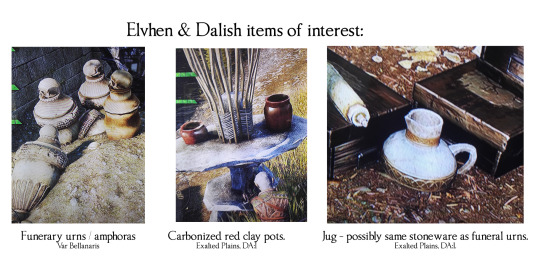
The burial urns, as seen for example at Var Bellanaris, are fascinating to me - they got me thinking that perhaps pottery is not so much seen as a practical craft among the Dalish, under June, but more under Falon’Din’s jurisdiction. The urns are also more like an amphora in design in that it is not free-standing, which might be why so many of them are cracked from falling over.
In all honesty though, to test my theory further I went running around Stone Bear Hold and well, for a fairly isolated culture that uses pelts and animal hides in their armor, they sure do have the exact same metal and wood items in their kitchens as Ferelden or Kirkwall homes. So in essence, inconclusive.
There is one type of drinking vessel that I believe is salt-glazed red stoneware. I did most of my digging for shards in Inquisition, and then thought, hey, I could take a look at what goes on in DA2, and well, it turned out that there’s a lot of recycled assets between the smaller props of the game. The same red container you’ll spot both in Gamlen’s house, in the Black Emporium, and in Var Bellanaris in DA:I. Lore-wise this would mean there’s either a whole bunch of raided Elvhen pottery in Kirkwall, or then the Dalish are okay with some Free Marcher wares in their tombs.
But, I found this one shelf that judging by how the items reflect light, there’s at least one type of thrown, glazed drinking cups in the games (DA2 & DA:I), and I believe they are salt-glazed. The second salt-glazed pottery I could find, would be the Grey Warden ritewine bottles, which there are plenty of at Skyhold:

Salt firing is a kiln-firing technique. In it, sodium is added at the end of the heating process. It vaporizes and condenses on the crockery (any surface really). It can create an orange-peel texture, or the streaky, shiny surface that we see in the game.
All of these items are red clay. Red clay is clay that is iron-rich. It’s easy to build large items from, and quite common in soil. The downside to red clay is that it does not withstand high heats, since it will melt and ultimately boil at high temperatures (past 1050 degrees C) due to the iron. This process of the clay melting is called vitrification, and it starts at around 600 degrees C, and is essential to make the ceramic wares transform from porous earthenware like flower pots to non-porous stoneware or porcelain, like plates or cups.
In Thedas, all of the Ferelden regions have Iron, and therefore I believe these are iron-rich soils and most clay would be iron-rich. However, even areas like the Forbidden Oasis and the Hissing Wastes seem iron-rich judging from how red the soil is (I assume it’s red shale, which is a sedimentary, iron-oxide containing type of rock). You’ll find red clay items in Kirkwall, and Bram Kenric has a flower pot in his window in the Frostback Basin that looks like red clay with a slip decoration. The Avvar have a pretty neat-looking statue next to Svarah Sun-Hair up in Stone-Bear Hold.
In general, the crafting materials are a completely indecipherable mess pretty wild, and I’m definitely not through with figuring out everything, but areas with Obsidian - a felsic volcanic rock - might be iron-free. We can see some yellow pots in Val Royeaux; they are sturdy, and unglazed, so I assume there’s a sallow earthenware clay somewhere in Orlais as well. There are also some rather fascinating items at the Val Royeaux market place, so who knows - I didn’t have a good save game to run around Halamshiral in. They could be enamel metal items as well, but look like ash glazes to me:
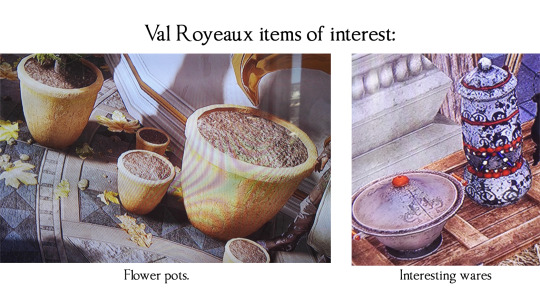
But, what about other clays, like porcelain? Well, my most educated guess is that the continent of Thedas does not quite have it, and doesn’t quite have the craftspeople to create it. On earth, porcelain clay consists mostly of the mineral kaolinite, in its purest, ground form, kaolin, named for the Chinese village of Gaoling where it was first achieved some 1200 to 2000 years ago. It’s mixed with mica or feldspar to form porcelain clay, and fired at temperatures from 1200 to 1400 °C, and can be decorated in wonderful colorful ways. Kaolinite is very common on earth, but pure white kaolinite is not, and figuring out a recipe for a clay that gives the durability, translucency, whiteness and thinness of Chinese porcelain took Europeans very long.
Still, from running around Thedas I noticed that in the Emerald Graves, many of the pebbles lining the paths are quite bright white. So, with that in mind, it isn’t a terrible stretch that there could be a deposit of kaolinite, and thus a possibility of porcelain. Perhaps those Dalish jugs are porcelain after all?
Anyways, thank you anon for asking! I am of course only speculating with all of these, so don’t take them for fact :’)
13 notes
·
View notes
Photo

Aaaaand I guess I might as well post this sketch while I’m at it. This one probably won’t be finished (considering I started it to celebrate back when my Warlock got to level 15 and changed her subclass l o l), not least because Photoshop did something wacky to the opacity and I really don’t feel like redoing all those lines.
Inna-18 the Sunsinger is my own and Mica the Gunslinger belongs to @volcanic-interruption. Sorry sis, I’ll draw ya another Mica to make up for it :3
#solar sistas aw yeah#destiny#inna18#mica dumbass#you told me that was her name and that's how i'm tagging her until i hear otherwise#galactina art#that's not temporis floe or raku izumi that's nemesis plane h a
5 notes
·
View notes
Photo

And finally. @public_share @tetoiuku #experience #repair #gold #mica #reformation #raku #kintsugi (at Avondale, New Zealand)
0 notes
Photo
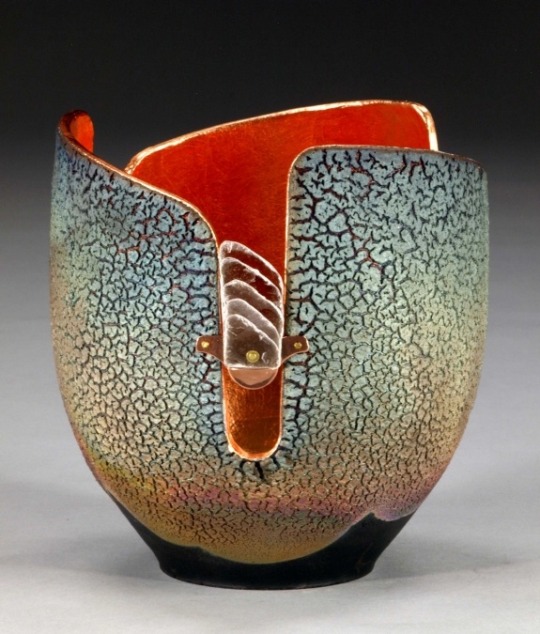
Just Pinned to Art: Copper sand Raku, copper, hishi bead, mica Currently at Hunter-Wolff Gallery http://bit.ly/2AJhXfh
0 notes